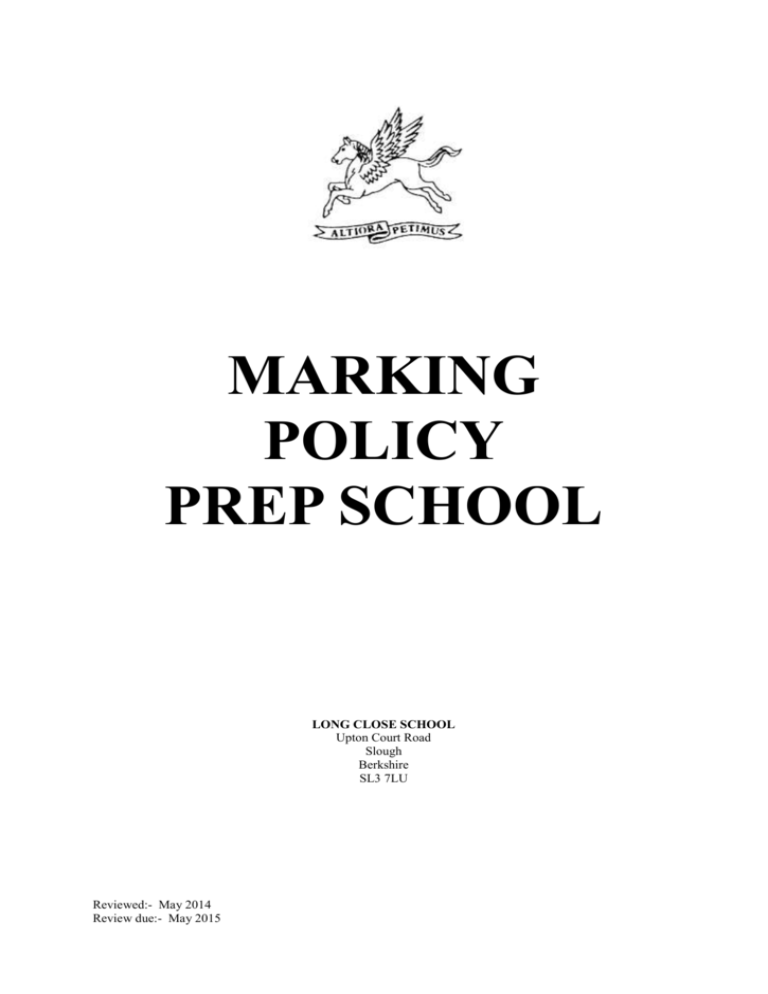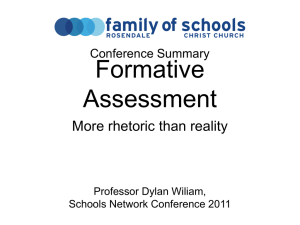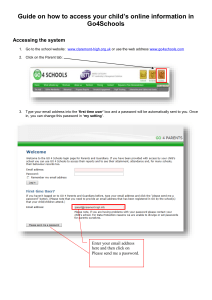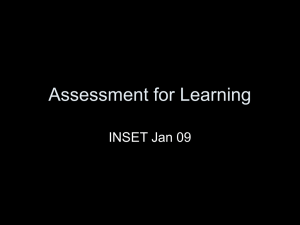Marking Policy - Long Close School
advertisement

MARKING POLICY PREP SCHOOL LONG CLOSE SCHOOL Upton Court Road Slough Berkshire SL3 7LU Reviewed:- May 2014 Review due:- May 2015 LONG CLOSE SCHOOL MARKING POLICY Definition Marking is a response to pupils’ work. It may take the form of ticks for work seen, grades or marks for tests as well as written comments for key pieces of work. It contributes to the continuous assessment of the pupil. Aims 1. 2. 3. 4. 5. 6. To motivate and encourage pupils To gauge pupil achievement (within clearly set learning objectives) To monitor pupil progress To advise parents on how to improve To inform parents and pupils To provide feedback on teaching and inform future lesson planning. Practice All finished work produced by pupils should be inspected by the teacher and where appropriate given a mark or grade. Incomplete work should be marked as seen and a note made for work to be completed. Key pieces of work should be marked in greater detail providing feedback, positive criticism and advice on the ways that the pupil might improve their work in line with assessment for learning (AFL). Verbal feedback, which forms part of the marking process should again, be positive and give guidance on how best to achieve future aims. To show that verbal feedback has been given put the symbol after the work to show that you have spoken to the pupil. Marking MAY BE DONE (and, for younger pupils, is preferable) in the presence of the pupil. Smiley faces, stamps and stickers may be used to reinforce positive feedback. Marking must take into account the needs of each individual child and comments must be clear, concise and positive. Pupils requiring learning support and younger children need not have every spelling error pointed out. Instead a selection of two or three words that are within the capability of that particular child should be selected. These should be listed at the end of their piece of work and copied out about three times. They may also be included in a word/ vocabulary book. It is important not to discourage usage of a wide and varied vocabulary for fear of incorrect spelling. A more structured approach is needed from Year 6 upwards. Symbols and comments will be used widely. It is hoped that during Year 6 many pupil’s work will be marked in a similar way to that is used in secondary schools – this will aid progression between the phases of compulsory education. The use of the following symbols will help to promote consistency and clarity in our marking: Reviewed:- May 2014 Review due:- May 2015 A Guide to Marking: Symbols The Target Symbol (written in the margin or by the target) Action Indicate a good point or correctness. Possible improvements could still be suggested. Indicate an incorrect point. X Discuss or write down correct answer. Indicate that something does not make sense. ? Put an explanation in the margin or an * and an explanation at the end of the week. Indicate a spelling mistake Write the correct word, first three letters or just in the margin. The action taken should comply with the whole school spelling policy. A word or phrase is missing. Indicate missing punctuation Indicate that a new paragraph is required. Abs If possible put a few words in so the pupil can see where he/she has gone wrong. P If applicable put punctuation in so the pupil can see where he/she has gone wrong. Discuss with the child when new paragraphs are introduced. NP // Indicates a grammatical error GR Pupil to correct the grammatical error with assistance if required. Poor Expression PE Possible improvements could still be suggested The pupils are gradually introduced to the marking symbols from Year 3 up; with the symbols used being appropriate for the age group and achievable. Reviewed:- May 2014 Review due:- May 2015 Marking should: Be done as soon as possible after the completion of the task. In principle within three/four days for the core subjects, within a week in the non-core subjects. Be based on clear criteria. Responds to the learning objective and success criteria of the activity, which must be shared with the pupils. Marking is targeted and follows the principles of AFL to comment on what has been achieved and what the next steps are. Identify errors and omissions and suggest improvements. Promote high expectations and the development of high standards of spelling, punctuation, grammar and presentation relative to a pupil’s normal attainment. Be written legibly and in the language the pupil can understand. Marking in Key Stage 2 There is a progression of marking procedures throughout Key Stage 2; in order to provide a smooth transition for pupils to become increasingly more independent learners. All work is marked in the children’s exercise books with diagnostic comments when appropriate. This should show a child how to improve upon his/her work. Following the principles of ‘Assessment for Learning’. Comments respond to the pupils’ success at achieving the learning objective and success criteria of the activity. Where the work was discussed with the pupil, this should be shown by recording an ‘S’ in a triangle on the piece of work. The marking and assessment is used pro-actively in order to give the pupils specific learning targets to work on throughout each term. (See Target Setting Policy) Grading or levelling would not have to take place on every piece of work, but be regular enough to give information to staff, parents and students. Marks which reflect evidence of formative assessment eg spelling/ tables test results and NC levelling must be recorded in the teacher’s mark book or planning file. Where appropriate, exam marks, progress grades and diagnostic tests to be recorded in mark books and on the intranet. Grades, marks, test & exam results, assessments, examples of pupils’ work and annotations should be the basis for the overall achievement grades in the half-term and end of term Progress Reports and also the end of year reports. Formal assessment marks ie. exam marks, progress grades and diagnostic tests, are also to be recorded on the Intranet; under Children’s Diagnostic Records and also Pupil Asset. These records are passed on to the pupils’ next Form Tutor in the Pupil Records’ File. Marking must take into account the needs of each individual child and comments must be clear, concise and positive. Pupils requiring learning support and younger children need not have every spelling error pointed out. Instead a selection of two or three words that are within the capability of that particular child should be selected. These should be listed at the end of their piece of work and copied out three times. It is important not to discourage usage Reviewed:- May 2014 Review due:- May 2015 of a wide and varied vocabulary for fear of incorrect spelling. Older or more able pupils should correct spelling errors by using a dictionary. Marking Specific to Years 3 & 4 Years 3 and 4 are transition years between Key Stage 1 and 2. When the children arrive in Year 3 they are still infants and the Year 3 teachers begins to train them in the expectations of the junior part of the upper prep school. This is further progressed by the Year 4 teachers, who give the children the skills required to go on to a more formal style of teaching. Here the children can succeed with the expectations of becoming increasingly more independent. Marking is based on the effort the children put into their work. Pupils are given an Effort Grade for most pieces of work. This gives parents an idea of how hard the child is working. Marking Specific to Years 5 & 6 Effort grades are given for most pieces of work. Additionally teachers may mark using NC levels and when appropriate attainment grades ( A-E ). The teacher can write down a percentage score, where relevant. The attainment grade must be based on the school’s system of marking exams ( see Progress Report guidance .) Diagnostic comments would mainly be accompanied by the attainment and effort grade. The attainment grade is based upon national expectations for the pupils’ respective year group. The effort grade is based upon the individual’s personal efforts on each piece of work. Therefore, it is possible for a weaker pupil to attain for example a ‘C’ grade, whilst having tried hard and achieving ‘1’ or ‘2’ for effort. KEY TO GRADES These are based on national standards ACHIEVEMENT EFFORT A* = Excellent standard. 1 = Very good/ Excellent. Tries very hard A = Very good standard. 2 = Good. Tries hard. B = Good standard. 3 = Average for the age group. An acceptable level of effort. C = Average standard for the age group. 4 = Inconsistent effort. Needs to work harder. D = Below average standard. 5 = Unsatisfactory. Little effort being shown. Reviewed:- May 2014 Review due:- May 2015 Marking in Key Stage One All work is to be marked and comments written where appropriate. The comments should link to the lesson’s objective and provide advice as to how the work could be improved. (A tick and a wish system) Whenever possible the work is marked in the presence of the child in order that the comments can be explained. Where this hasn’t occurred, children should be allowed time to read or discuss work marked. Self-assessment: Where appropriate children through questioning should be asked to identify their own mistakes/next development point. To show a correction the symbols . or c is to be used. The following letters are to be used: ‘SC’ for when a child has self corrected a piece of work. ‘H’ or ‘Help’ for when a child has been given assistance in the completion of a task. Verbal feedback has been given put the symbol after the work to show that you have spoken to the pupil. Smiley faces, stamps and stickers may be used to reinforce positive feedback. When correcting spellings not every incorrect spelling needs to be highlighted. High frequency words relevant to the year group should be corrected. If in Mathematics the child has used a number line or another piece of equipment then this information is to be recorded on designated work. Monitoring The Head and the SLT are responsible for monitoring the quality and consistency of marking. Work from pupils will be scrutinized on a regular basis. Those involved in the monitoring will give feedback on the quality and consistency of the marking. Reviewed by: S. Field, Head of Preparatory School Reviewed:- May 2014 Review due:- May 2015







